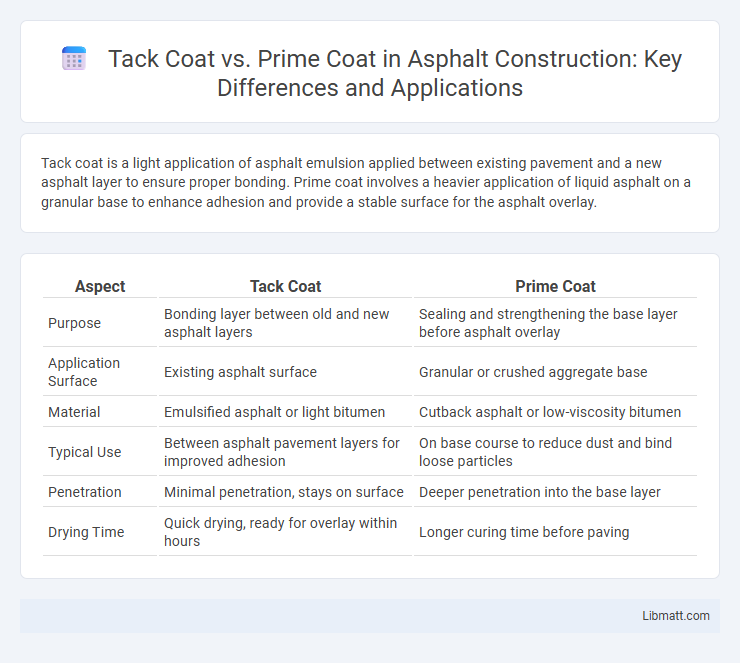Tack coat is a light application of asphalt emulsion applied between existing pavement and a new asphalt layer to ensure proper bonding. Prime coat involves a heavier application of liquid asphalt on a granular base to enhance adhesion and provide a stable surface for the asphalt overlay.
Table of Comparison
| Aspect | Tack Coat | Prime Coat |
|---|---|---|
| Purpose | Bonding layer between old and new asphalt layers | Sealing and strengthening the base layer before asphalt overlay |
| Application Surface | Existing asphalt surface | Granular or crushed aggregate base |
| Material | Emulsified asphalt or light bitumen | Cutback asphalt or low-viscosity bitumen |
| Typical Use | Between asphalt pavement layers for improved adhesion | On base course to reduce dust and bind loose particles |
| Penetration | Minimal penetration, stays on surface | Deeper penetration into the base layer |
| Drying Time | Quick drying, ready for overlay within hours | Longer curing time before paving |
Introduction to Tack Coat and Prime Coat
Tack coat is a thin layer of asphalt emulsion applied between existing pavement and a new asphalt overlay to create a strong adhesive bond, preventing slippage and ensuring pavement longevity. Prime coat, typically made from asphalt cutback or diluted asphalt, is applied to a granular base to penetrate and bind loose particles, enhancing surface strength and stability before asphalt paving. Both coatings are essential in road construction, optimizing pavement performance by improving adhesion and base integrity.
Purpose and Functions of Tack Coat
Tack coat is a thin layer of asphalt emulsion applied between existing pavement and new asphalt layers to ensure strong adhesion and prevent slippage, enhancing the structural integrity of the pavement. Unlike prime coat, which penetrates and seals the base layer to provide a stable surface for the overlay, tack coat specifically acts as a bonding agent to improve the pavement's overall durability and lifespan. Understanding the purpose and function of tack coat helps you optimize pavement performance and reduce maintenance costs.
Purpose and Functions of Prime Coat
Prime coat enhances the bond between the existing surface and the new asphalt layer by penetrating and stabilizing the base material, ensuring improved adhesion and structural integrity. It seals the underlying base, reduces dust, and provides a uniform surface for the subsequent tack coat or asphalt layer. Your pavement's longevity and resistance to moisture damage depend significantly on an effective prime coat application.
Key Differences Between Tack Coat and Prime Coat
Tack coat is a thin adhesive layer applied between old and new asphalt layers to promote bonding, while prime coat is a penetration or cut-back asphalt applied on granular base materials to improve surface strength and adhesion before asphalt paving. Tack coat mainly enhances the interlayer bond in pavement rehabilitation, whereas prime coat stabilizes the base layer and prevents moisture infiltration. The chemical composition differs, with tack coat typically being emulsified asphalt and prime coat often consisting of liquid asphalt binders designed for deeper penetration.
Materials Used in Tack Coat vs Prime Coat
Tack coat primarily uses diluted asphalt emulsions designed to create a thin adhesive layer between pavement surfaces, enhancing bond strength. Prime coat materials consist of low-viscosity bituminous binders, such as cutback asphalt or asphalt emulsion, which penetrate the base layer to stabilize and prepare it for subsequent paving. Understanding your project's requirements helps determine whether a tack coat's adhesive emulsion or a prime coat's penetrating binder is the suitable choice.
Application Methods for Tack Coat and Prime Coat
Tack coat is applied as a thin, uniform layer of bituminous emulsion using spray bars or distributor trucks to ensure proper bonding between existing and new asphalt layers. Prime coat involves spreading low-viscosity bitumen or cutback asphalt by brooming or spraying over granular base materials to improve adhesion and provide water resistance. Both methods require careful surface preparation and controlled application rates to optimize pavement performance and durability.
Factors Affecting Selection of Tack or Prime Coat
Selection between tack coat and prime coat depends on surface condition, pavement type, and environmental factors. Tack coat is preferred for bonding between old and new asphalt layers, especially on clean, dry surfaces, while prime coat suits granular or untreated bases to seal and strengthen before asphalt overlay. Moisture content, temperature, and type of aggregate also influence the effectiveness and choice of the appropriate bonding agent.
Performance Impact on Pavement Longevity
Tack coats enhance pavement longevity by providing a strong adhesive bond between asphalt layers, reducing the risk of slippage and reflective cracking. Prime coats improve substrate stabilization and moisture resistance, which helps prevent base weakening and pavement deformation. Proper application of both ensures structural integrity, minimizes maintenance costs, and extends asphalt pavement lifespan.
Common Problems and Best Practices
Tack coat and prime coat application often face issues like improper curing time, uneven application, and contamination, leading to poor adhesion and premature pavement failure. Best practices include ensuring a clean, dry surface before application, using the correct dilution rates for tack coats, and applying prime coats on granular bases to seal and strengthen the substrate. You can improve pavement durability by following manufacturer guidelines and monitoring environmental conditions during application.
Conclusion and Recommendations
Tack coat and prime coat serve distinct purposes in asphalt pavement construction, with tack coat providing bonding between old and new asphalt layers, while prime coat stabilizes the base layer and enhances adhesion with the asphalt surface. For optimal pavement performance, use tack coat when overlaying existing asphalt surfaces and prime coat when preparing untreated base materials. Your choice should depend on the layer conditions and project specifications to ensure durable, long-lasting pavement.
Tack coat vs Prime coat (asphalt) Infographic

 libmatt.com
libmatt.com